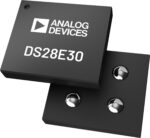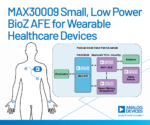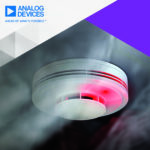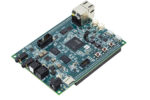Power management encompasses a range of power converter types and topologies and includes systems like ac/dc power supplies, dc/dc converters, LED lighting, and battery chargers. Designing compact, cost-effective, and efficient power management systems is challenging and requires a combination of skills in high voltage and high current design, control loop optimization, mitigation of electromagnetic interference […]
analogdevicesinc
Precision signal chain platform optimizes system performance in DC to ~10 kHz applications
Analog Devices, Inc. introduced a precision narrow bandwidth signal chain platform that optimizes system performance for signal bandwidths of DC to approximately 10 kHz in industrial and instrumentation applications. The new platform offers a host of complete signal chains with customizable solution options and a curated suite of development tools to simplify the design journey. […]
Cryptography tool protects products and integrates with 1-Wire
Analog Devices, Inc. introduced the DS28E30 1-Wire ECDSA Secure Authenticator, a cost-effective solution to detect and help protect products from counterfeiting or misuse. Combining a fixed-function cryptographic toolbox based on the industry-standard FIPS 186 elliptic curve digital signature algorithm (ECDSA), secure storage of keys and application data, and the single-contact 1-Wire interface, the device easily […]
Analog front end reduces, size, extends life of remote-patient monitoring devices
Reduce the size and extend the life of bioimpedance (BioZ) remote-patient monitoring (RPM) devices with the MAX30009 low-power, high-performance BioZ analog front-end (AFE) from Analog Devices, Inc. (ADI). For developers of small, battery-powered, continuously wearable devices, this AFE on a chip offers clinical-grade vital sign measurements of bioimpedance analysis for patient health assessment for wellness wearables and […]
Stress & Strain, Part 2: Implications for electronics
The mechanical strain induced on electronic components due to mechanical and thermal stress is an important aspect of their performance consistency and limitations; stress is also used to enable some materials to provide critical electronic functions. Part 1 of this FAQ looked at the basic principles and tests for material strain when stress is applied. […]
Stress & Strain, Part 1: Fundamental principles
The mechanical strain induced on electronic components due to mechanical and thermal stress is an important aspect of their performance consistency and limitations; stress is also used to enable some materials provide critical electronic functions. Although electronic systems and circuits invoke intangibles such as voltages, currents, power, EM fields, and Maxwell’s equations — to cite […]
Smoke detector reference design and algorithm is UL217-tested and verified
Analog Devices, Inc. (ADI) introduced a reference design and algorithm that enables small form factor, low power, smoke detector designs to be rapidly prototyped and brought to market faster at a reduced cost. The new CN0537 reduces design risk and has been tested and verified to pass the UL 217 Standard for Smoke Alarms, 8th […]
Filters, Part 1: Analog, switched, and digital filters
Filters are essential functions in most circuits and systems; as frequencies extend into the multi-GHz range, surface acoustic wave (SAW) and bulk acoustic wave (BAW) filters are needed to meet the design objectives. An engineer I worked with (and whose name I have forgotten) once remarked to about electronic filters (and he was serious): “like […]
Hardware/software combo leverages audio bus technology to deliver hi-fi multichannel digital audio
Analog Devices, Inc. (ADI) introduced today a full audio system that features the SHARC Audio Module (SAM) for the creation of digital audio devices, including audio FX processors, multi-channel audio systems, MIDI synthesizers, and other DSP-based audio systems. SAM includes the dual-SHARC+ core ADSP-SC589 audio processor SoC (with an integrated Arm Cortex-A5 core) and leverages […]
Analog Top Talks in November 2019 on EDABoard.com
Peer-to-peer, engineer-to-engineer questions and answers from the EDABoard.com engineering community around analog ICs and analog design. Click the “Read more” link and follow the entire conversation and maybe add your two cents by logging in to EDAboard.com. NPN having its VBE protected against reverse voltage – The attached circuits provide an 8.3V rail which supplies […]










